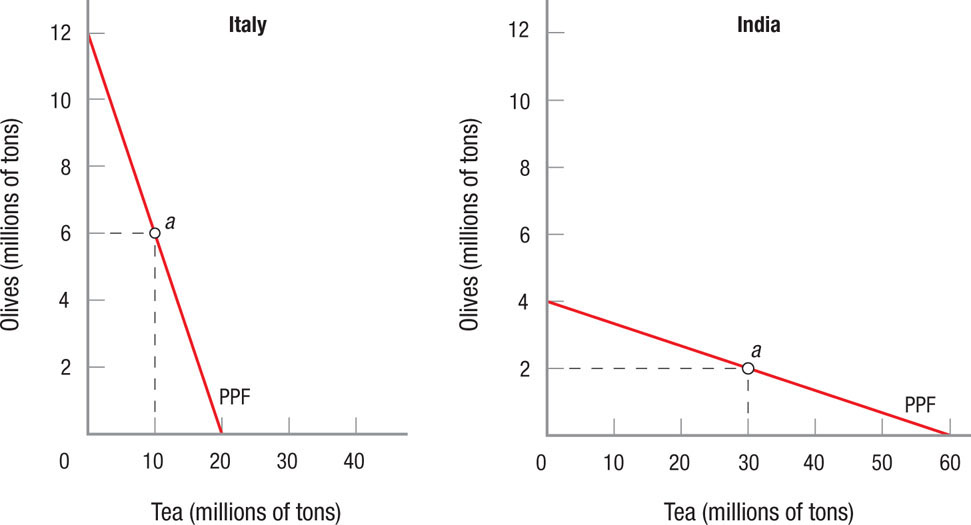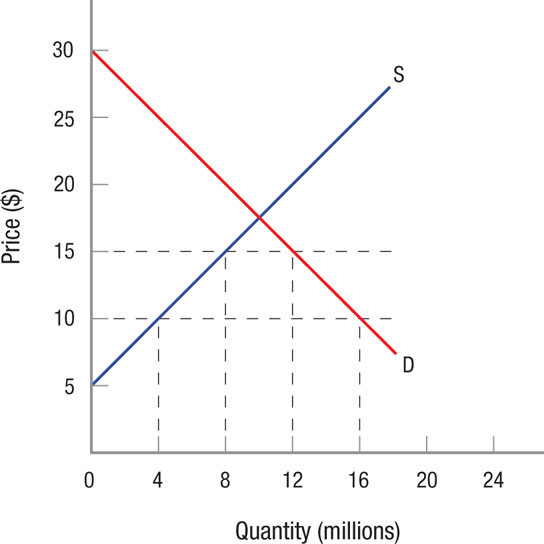Questions and Problems
Check Your Understanding
Question
gRlEiHvr+SbxoHgSvY0XT+HwoTnYNALidRv4H1p4OLIiG++PKZlazO20dsJLC17+vp3rn6y5bguFL76rpcoV6MKbyXTev90w2S+GRPjTNuTdAuh8DS0lmzA6liQoSaeXN8oWsANHBmLRZioJIqNJwL7ccM4/w75IE7HHGjZnIZNHJ6n1OiR8ZuqcvvKT2NC4ONtxCq7fJJqqYatqPcdlaH8eAeFEw8HFvknUFlgHSt7lcA9g/AYGzS3hToM=Prob 15 1.What is the difference between absolute and comparative advantage? Why would Michelle Wie, who is better than you at both golf and laundry, still hire you to do her wash?Question
LzQX+f+IHW3wKfWOoqi8gm76bvwu1p3VZnSjmjc6UHgBRoNXZ4hlirJ3QWtCZALke48M3etCySZUS9GGPnX5+jSt/QiZlloLDe6G7zQ5D/2dngRpvsGepgOpoeEL8F4IVQqFQOW3OKT4fER9oSaFlThkrUfNdUIuzk4kxd2AtgNGdNlFDVSmQ3u3UzCarQicKiCKURWQKhUCoovCoyiRsrXLtlzpu7M/s5448Es2ioNOZA+g8c+ZM/WBAFJPbmBDProb 15 2.If the United States has a comparative advantage in the production of strawberries compared to Iceland, how might trade affect the prices of strawberries in the two countries?Question
qHuFIC+QSI7DY6c9oyFaGEU5hk09EHoOCN0dfBtLbJxYcrBUNi33m7Npr059OZbaspDPhBRuiBRJihjU2WjPLPprmbxEkRgUJPyA57F9XR5LqvIOYj4UylSe5ND4IklKeXDKSaKspVt4Pvo5VZ0GvzMxWpw=Prob 15 3.Who are the beneficiaries from a large U.S. tariff on French and German wines? Who are the losers?Question
Zc49qE/aH9K9ICJkS3Di9mb7dApPvgqMAtiE3WWLt8VRv9HxhXJ8AlA/dXup6dxtW+zxJdaQzSC3rjipnTusXSUFzweJZeEP9NF2MenKC1puRNqdR8tPuPZYRhNDpX5ZQhJ3moW1tFmdTVmjCXtWKjrzaSBPBbkcJiquwg4q8/SoJff8Ku6SSzJoUyA=Prob 15 4.Why does a quota generate a larger loss to the importing country than a tariff that restricts imports to the same quantity?Question
bNoOYcjsggSJfYojlZxdznjQXFbnDnhIICUj9c5o1X+ARTMyyC+lztl1uC/zZiPFEN020UnqqRHTOdvCIbeE5Hh8ePSiRamjghmtlyHrldN3j9rrnBVyNKkTPWo8vAizzGOsO+oKgq0gKW2yRrBNrykepiLidJvrOnyt4m4cCoCHhApTaUVcFVv5qmoFJC2FwtG30lDyIXebVawVahkxbe+sIUc=Prob 15 5.What is the difference between an infant industry and a key industry? Why do producers in both industries desire protection against foreign imports?Question
CV0Wud2Gc/7oRI5HlCe3F1qWNs2p4/dPgSPRV6JZt/i1uXzJEvLzPSKOkkFztjOkWpzldvzSv0OwVnD8BiRq9If95gNiJ9Py5eslJa8btFqrVTpiGDI/elC382fys6ogbKl1FWtnPuc+/22mL1A0eJtJnlEJIE5TqZJUYQ2JSzAcZ3A5ME9Tlg==Prob 15 6.How could free trade between the United States and China potentially lead to more jobs in the United States?
Apply the Concepts
Question
2BXAC6M1z6e0nH7a2Nu2giKMxX9FRpP2QAlA3zThcNKS7nd8JRHjMt6Ty6YdBiIz9sZD4uLbElytAbGc/4vj9fKwPxSLYhVRdVexI0fO5D6DWZZM8ZafFohxKARvbbXtW3p1PsLk/NHNcutge99/Tu7G3u5GV8XKkd2HyxQJ7XeRDq5Ka1s9YK5zoF7aKU2SSpQX6zTahDj35M88jhdzky47wWWRHjMXQx+mDRCg3XvDghjfkdjyMooQooip01VOA+WeW/qgLyPjp4zRKvOBoWwPkZ4l3lle8iFdoifI5TdioZ/EWiFYSH+aW0pMFMSNTPDHYU0JpDr182zBfrbnCaAWGaixX3V7UFK+oFFU3ut86kLB0B3YjKBHEvcy31cipWAbiE/gNizoMu109A1D6kdo3R5+O2vrQCq6F5V6h+4ksMYirHrNUQ8iI57y+KRZ6tYh/kkj0uy8w2bxtx5WrZy4eVX9iVShB/NlAZzbHop/Rd/atEFryR94wXBuqyJzVmRigjP1tzO6CGV/BQceCuQTSpC/gFbxZX4LQRz11bvjTZqd2crWq7qv5YHo+S89IwjuRNbJ+INt1i2oyk0cX+8Cosw73x8Ol/nu3qjMbNFGnJ1aiaJyzwZutXX9MJbXzEwULGXfAMS1G+UK23bOYxqRPpMdm0UExXqJbI/ewgBFvXMv8hI/KkNofAZfWuYmYup96mNMCwXSIPAtSxYkkwSBW/qy31Sn+fMdKhZUHPVV4GKoebPHxkdvkqosXckpEIIfxt5gKx7B1I10TA1fDSJtmSqt/U4aLaYWwwk1VhvL0e1SPbDEDp5KvWFVg0tYUkjt0NdCV4A7nmO5S8cspq5MSAEHbxMHJsmMzWg/HvhXH32Ko6/vSuuG9hIZ1sz/D15REtUg/0RICgZZz8usLwyO6xas7hHYZpMSxrmZ2yIjwEnLKk+rmF1/DnH6gYeXpGWGCniQIuAkk/tyProb 15 7.South Korean film production companies have been protected for half a century by policies enacted to protect an infant industry. But beginning in July 2006, the days that local films must be shown by any movie house was reduced to 73 from 146. South Korean film celebrities and the industry fought the changes even though local films commanded half the box office. Why would a country enact special protection for the local film industry? Who would be the major competitor threatening the South Korean film industry? If films made by the local industry must be shown at least 146 days a year, does the local industry have much incentive to develop good films and be competitive with the rest of the world?Question
M3NIaozI7MtUpyLnw4/ruO21Pihg80DsACMg81OE4emRxIXL/saoSw7A08Qm3msXUonoJCXqqD2CZKDKgmDNboWKYhWXtXnzEvMu18QXFteFfY5lmg5fv2M0lnRY1MlAdaOrBf6x6uO6d91R9a5QKiOZoojk6O+9sxpiQS+eImoz+fW9bZtm1AgNSu/odtFsX5ZB8eblxrt+tPsLl6Ci0Be1o9x9aQdOGfCZ1a2gI++D6FH7kCzHeO9c8uWSSenzKprAMZpngYhQnJcTocwB8H2koVJ8lFWrRaQWnbo4mWWk53nJDO1yCQ+XSEqNcudzuGwXxgXmVPRxgO+88nWPBw6naQ3bkq1sLgUUijXk9bH1Ulf+bkKw6G4ecVF0WJap9dgUM0NhyrbfNgqPx9TXbLyde4bz9LOJkmxY20Np+ro=Prob 15 8.Expanding trade in general benefits both countries, or they would not willingly engage in trade. But we also know that consumers and society often gain while particular industries or workers lose. Because society and consumers gain, why don’t the many gainers compensate the few losers for their loss?Question
8YLGi1b0mpN3MHa4y72SK2S4q9ZepGvLPSoOOHV62VXyayjNSuUum2ZQqUT1zCZlV2tUnMSoQ4SYL/s6lC41/vbcPojycKAqbex66dSEE95OTJEONeY7g0ttVYAAoX4ZB6bM75RsN/Zoa0cR4OB6+5MWdzE2Nxo6brPqBFSetI2MIYA8IPguEEixLGaooV1iw9hyiLE7m/pw+98P1htWlhuiJeiAnSWWatFD5x14gw1ac7RRV8T71/4uy9DLLz23vVLyFCarVOsPq9Y1TTkGzXBjM94oTOVcKUw+vQFO9rtJ2qHsJfrNRAfjGBLOQ/rk9xlTe/ygFrD3R4WNMPF2hUFd/+zbPetCoSsZFQUhltJcI4LbxdIY+CWK5Jue9Ja6CAYo4F2LD23Z3HAb10TFkZgCHy8xa/wUMalwvKzvB6cZ28abjsKFlXRi9X+Cu0nzk8n20bxPXzDa3sNPVMDTVot9cWybtckGvPKjqCJosHo1iJrAtAInZ/j7Fv0Rc9mhYYU9AtGQQwE=Prob 15 9.Some activist groups are calling for “fair trade laws” by which other countries would be required to meet or approach our environmental standards and provide wage and working conditions approaching those of developed nations in order to be able to trade with us. Is this just another form of rent seeking by industries and unions for protection from overseas competition?Question
LAC7ZXHT2s45nnnovQupIQyYBb5dWqVa5syq2shYX4uZgeF+bTQAis8LVE9DnP6TRHYEyVwc/FxP6RVQjEhEmXVVQawqn+dnV+cEqj2Y32+nzAcg96T97tXk5F9mWBlWLUULNt/WRX//qQAZiA5KzjldUGg=Prob 15 10.Why is there free trade between states in the United States but not necessarily between countries?Question
VQ/faV89h20UDPL4pA9TAnYh85JV/9Ghr/XTq2BJ+IuIv8Ozld7wIjWUQ6VLQ+vBezBx7ThXLhId6O55tRBT/LI1VNLWEWtGtWek+U3y57oUbt/U4Kendjx6cx/TPFwbUulwNB6JBhMXBMV6fEPXjvmaQ1lkasRwA7PRtl6TOCqTbvUVNZyPsbhNKSx0SfgnUJJeDrMG+kU9YG7kFRhHBL2/ekqD5es+TSXiAfYEp+do1WrUmrQmaQdTjSHR/jsnx9qOV2w67B9zv9rVpbwpa0XdIO3LP9m/XzwD1rC8pBami2f8xQrJ9xkiWCm8+797ejyRkB+I28ySli4lPCsUSLpCqWUnnKBMPPJBqrKX08WZ+ikMcU4A3f0OxIrurQZAIM6Y204u5uurl8qUNKFiJEq5j4rSYhbFs9kOuuNeGuvRNibX84AtqPKACMk27LuHnSmlSbSQA3xV8wM7pAytZg19KcgZraVaOysw/Mdk9/g=Prob 15 11.Remittances from developed countries amount to over $325 billion each year. These funds are sent to their home countries by migrants in developed nations. Is this similar to the gains from trade discussed in this chapter, or are these workers just taking jobs that workers in developed countries would be paid more to do in the absence of the migrants?Question
7HUfjWOobQuPN8PZUDyneIAI44067exRR1tbGe+z9doAzpn2AygmTVPYRT+lD392R4bVc6P1u4oLaIN/p4Ij7TW03kFqcyJ6vnVqRRbb2NsyHC0Jj9+H1v6LGbHg7WfbheLBRmEkrrr/HTz+q9lldrj4NUEIistuNeF+3iGHBpAJf6dirqzlMFWD9XXNMgsHTq/TAtLdGDHNVvJelX56CcPlkpvQ4BuyDbawvkUeNn+Gy5ygy/CJMnKktleE2whAGGO1kE7SKz+Jp2Scc7ZpAQN2LqCdh0NYMdwjnzdT/ARTezJpDrMva4Df/ArDA4e2px2hKzcozbjGQycFoyS8Q/3TTjO0QHxnL3gO4VgO4EUC6T+V/gWmngB3QxaiYmBBYo/LjxqH9D6sSEGKGqk5PSXeRYLnLNl/BnQbZdKOxORqE6OtSO5jfqtklwvlUT4vTdSiBBH7OWz4MHCYyci1HtYfvnU4XcHMLpbx4qi6UdCLFkOEpDLG46UfnOLvrk2Np5E5l5Ucm+j8BacuyU1HamGI7SQHD+mk33Xk+Z3D1viFW81n2t2Eyw==Prob 15 12.Suppose Brazil developed a secret process that effectively quadrupled its output of coffee from its coffee plantations. This secret process enabled it to significantly undercut the prices of U.S. domestic producers. Would domestic producers receive a sympathetic ear to calls for protection from Brazil’s lower cost coffee? How is this case different from that of protection against cheap foreign labor?
In the News
Question
Tom4eOs0jHjVLA7pepWWf8tyN5u/vC0DAWMiOGPkMKnwP+ZkEAplEIgLpq3KTrQYODpZRV4/4HzPiu73XK4BIZtEwOxEGa2Vs5n6K63sdJ8PyAbQiTo4hRkeQUw7Mnie88/l1nJw22MacJpuoDZIvSf2/c5xTPRQXPnaR9lVjPnJ38i+oti+Rl5NEWBtp3SSSaL0XFW60uP3GtGWbYdDbaCKiwDUg7aeYBQP7UuO5yiK2sznAnTl3CLnOs2/Gilh91wznQKwUHB+/KvkJdSfD+2bmjptqXOSljAKu1RYG2Xqm5EifqWjlovFJCIjngoRflecCm41r5w325KguSCF8s2Pj4q3C+0n5wkWDCrHhT8oRxmIFlWyXbSiL6vBtzVGUC8L0oH2U50SVIpYoDOKviq7y8F6B2EwLRpQw0SJG/yFrlwP2JCw880KXzafjIP/KMUeU1+NSHA9+aRxuSGC2F3l2iYLAlIHYhq/xcavOyxfXXHMH74AwvoRpAasSVx4yYHolJz6aDKbgWGNObRRW/zl7SsJx7t1XYTACQD6RP+qk9hYP1YAfmvKQ+8lLJh2RFZsEEfHYgYcdhKxxYTeWNiQTHLrustex38SzHsabkO/LD76HEytSLmK3QMPgxXgGEd0qOnneOlkz0gEFyjydTFnHEOqELinnPCQRIk8ZQFY82sG3p/tqTowr+oNDS2BbOtY4spou2pz+F0+xqZ+D71Km5mW15pCcn/b7JkaFWOifomXg+tErlj0etPRYXURuu8LW3lnp0p4dwbMhXbhUdjuCHE0QYvfUoG4PeReWmm/nPc1mxixTBKue25lHpqQW0QProRG32w3/vvyYpPeWkSws/t21hM3zCOailSzOfw4nNEjDrfFpel1DgUt8aKTvOsPDXiYr5spm19KYmaicRdmbqbfbRAUbgWlgZ9QLEhQZAA5ZKcvv0gYm8DhbYb7gWLwI9RMCiQZn7JPYBDtcVxgko+ijV63Jup7xCpW+eAZlGwFSTVR5jrtpX5S2rOiNejBNQEEqSxeXu1U7El8eUxAhZdqkNkvWbANBkFBmES0EeRzkYnTHix+81WrOIb/Prob 15 13.Economist Steven Landsburg (New York Times, January 16, 2008, p. A23) made the point that “bullying and protectionism have a lot in common. They both use force (either directly or through the power of the law) to enrich someone else at your involuntary expense. If you’re forced to pay $20 an hour to an American for goods you could have bought from a Mexican for $5 an hour, you’re being extorted.” He also argued, “Surely we have fellow citizens who are hurt by those [trade] agreements, at least in the limited sense that they’d be better off in a world where trade flourishes, except in this one instance. What do we owe those fellow citizens?” The United States has programs to educate and retrain workers displaced by free trade agreements. Do we even owe them that? Why?Question
tuoSxrpLIBhti9hYbDmnbsk/pT90DhazslV1WzQEAbPj8efbAVP/2qp+QX5zEHbuO3ydMo6zd9MtQDcMItgGMBoELDHKzfQ9tcCDimslX3JPvhgy6abEUYhRbIS1OQ3JqPbXiiPGIsQMQhVywDDTB+jSwny0Xi1WaGnP3Xg0aKlJLYcOpbd+oLRSrrJs6TUAXqiuVvEH0IcCAs0IwCxjzODKccwxJe4ybzGWKvToS+Nka3w3pStdaijsx4HtgJ6CS3Vk2HX4uitEoJGIsZ3KU77Zbpoobx1rZCoAfV91b3MDrznTZ4OEcJe3LlyRodRmeW7aNdUqZh0hhiaSWVy7PoBmjZJOyzApI5GbkpAa3XhYdKCfOdwcHvJcmLFLUiji5MPdLQapvTUZGZU+3wIk0dG2GUdFg1dqrwmw6HMfU6snw/pcProb 15 14.The Economist (November 21, 2009) suggested that in a highly globalized world where production is easily moved to other countries, there is an inherent tension between our desire to reduce carbon emissions to stem global climate change and our commitment to free trade. Do you agree? Why or why not?
Solving Problems
- The figure below shows the production possibilities frontiers (PPFs) for Italy and India for their domestic production of olives and tea. Without trade, assume that each is consuming olives and tea at point a.

Question
ReRC1aYXW0Qln2A9gd4s2TwWFvwwUiPn5+j2Q02FqiwnW4pG/eH9gSVk+V6z4oPsggKF4dW3ylCdq7P6spRtD4RHnzORqTZDhsDZfOQTGVHT0WdVXLNlrYVhNQQvtxh27QwkkcnAmWdJGP1pP64h+b0/w+/Psz/8yGBtqPgsbvUYV157umix3ohDj/X/IPMBZaqL0DNH1bcU2Ub+F6bryJrzsB/0l0yZhbD3yW3Dtf7cASspNXXhK5NBu2f9z8tl0IT1k16SdCiypnkn8hXQ8x9tJWEJCRGgyqXMvXaXa7rsqukxProb 15 15a. If Italy and India were to consider specialization and trade, what commodity would each specialize in? What is India’s opportunity cost for tea and olives? What is Italy’s opportunity cost for tea and olives?Question
maRkZ8hENjFGnxZ2LIXPRT/FShtO/5TsFCupKBLdV+6bSRPedoOBvqcxTqtqi7VQ4D58wOiBlpJCd5s632VGYhHb3NFNlFzidmo+U/eyiqD1+CMQBUVu2L25B2xyiHzOf2TLI30F68unFckRo0W0jyAE5rHbq3AbrejZ/Bc+ga+Uj+OKPfcePGSblBQmd9LoBK+j1T3nIvKOzbgelp0BOPkpRvYyap/1KrLnwsLRfUiN86rPC/5BhR+0hodWjagkONPshbtLL+bB86xnoH9+MVdITcS3CSpn4y63zgzcbDxAhG5xAFT1rKQZ+Uwg99sCd2OSu+XUREY1pq6IfrR/n+b2CIUezrf8+tFbgWn4zGwk4/WuGKW+8zsUopMMCXH65jnbAudKtO2kMwct65XpMMB8W+OXT4xGAFys6QkPzuCUe7sO4xlf9Y0V2205qeAU3q9STRPF/UJKtg8fUcvgSs1lPMp1Qb5z/UOzVVGwvlvoQsl8bIoqXqSBgU2xF/feO4hjQyCI07ZeqPb0HMjr4l+tX+VF1lGN34eMPaCdtAwfY3pqUUG9IZBxOI7L1uQ8f3pVfOZwtajAvGLy8pCjd1ApW3dMuUiSDuQw17D4ALcFqxLAZerYAQ6i2D3oSzOLdmxlen00f1XKw+GoZbVz/x5M7RUURmnlxgtk+l81LmdAyVGN4yrtgz4J7/pJCwECCAzQxmzyfc3iD/HmO/DaibCw6fnw5a9UjP0yeLYF62F5J7+/FhoQaqoCvaU/Y36Vdo9g7B0hdblquBGG1XNqM8B1iOrTPzS8KXBqc1g20qGJtW/FbL6MyKm27SjBXlcDbJX0d/KfaJkd5mM6i7NqjhoIQrbfzDP3SpqPMw==Prob 15 15b. Assume that the two countries agree to specialize entirely in one product (the one for which each country has a comparative advantage), and agree to split the total output between them. Complete the table below. Are both countries better off after trade?
- The following figure shows the annual domestic demand and supply for 10 GB compact flash cards for digital cameras.

Question
7kfPDXZLxezywDsDsPJ162wQ1sXybS+Qkbt7GCo623n/aZdG0b8c7qIJGQl4Q7E1FGJ0Vzm8NOeShoZ5zm8+NB5aua1OrOmDx+Yzzpr2H6HN+bl9EEu+OiNSHiByy/UqKmuvYtG8s3gUdHA0YH9yez86UKZy7X+Po5T70KRx0v0iwcCtProb 15 16a. Assume that the worldwide price of these 10 GB cards is $10. What percent of United States sales would be imported?Question
IteWSyCPEgokVtbjVXQVp22Bi3gb4BIf+PySv48iaHBXDH3M5/i7GOHV8JmJu4+yz+9KnXdwOMXZiQtpGVUTeD329/1SG/TD09BjQixM5NJRa7jdNQ5tadLf+Y8AaYYKywQELWEZdLDawEIdAgEH/qVuhdN9pg3yhkLFyew5LREafIjOYSXSiRbAj7dUQ5ledPuCsbX6mXA=Prob 15 16b. Assume the U.S. government puts a $5 tariff per card on imports. How many 10 GB flash cards would be imported into the United States?Question
GdT9FxfnQ0fNbbE69rLDWSbHN6RiKRdjzG5HmxRQ/64WffWkyRCD9A5H2Qh4FrvI8lf3gGQycEniSVmL7+h1JaFhCo9lz7noCq2dkzBiCHR77c8SKrsYF2nFIm8VhbvGeKz28S4SC6tNaf35ZKzJEcJnDFU=Prob 15 16c. Given the tariff in question (b), how much revenue would the government collect from this tariff?Question
hJBJTrpNutjYq1up1ApXEyANUplAvURBIGYL3MB2sRXXHtcNcZ6ShE64nEMiAn+pwyb54mLjmyVLP578W1y4neJdLwC8YUp8QnfNPUiLcg1k1tGX5ck5woNmLcH3Xuqhu5POcEJOSKo1BDDx/sWgUH9Q2dfmRTqHhXV7xsLy23DUrqsx+KLJHw==Prob 15 16d. Given the tariff in question (b), how much more sales revenue would domestic companies enjoy as a result of the tariff?

Question
cQ3pRDhA7ACcS1q4V18LrThgZsbc1UucrYs6ajAtZs7abCM349LSnvcaC8runXvE9RZzmEyF/Rle2Z1lOolOQtlrXWLUiQCctfeSMXmXse+kUa+vg+II0VFBmhw2Rqk1WoOoOH42vOPL1nd2VsU98ihAMFFnWgoI1BvUCMjqLGAOdNqRcLWEfpq0O5PsTSZlKE8RY/WLVyVQtOkBPQojk4kuRRGi/l+5Q2nRKYbQW9uzTnAlE6MTukSVHh2RsAfcTna5Wytsn0bm8rmIVDMP0VE8gnBqXgT/ueaYnnuiXBlvXZpFBeadI1o9Qo98W50n7ySMsVbk/19CSpSN7sOUvf9lGtdnhNsCB0scSbaLX3X2duVWb+GhKA==Prob 15 17.According to By the Numbers, approximately when was the last time the United States had a trade surplus? As a percentage of GDP, what was the highest trade surplus the United States has achieved? What was the highest trade deficit the United States has achieved?Question
UX04YB6PCyCcks3k3eVUhaIe819WPpizzzi+V0VrP8j/33WZM7w4uEM2+OPDHyc5wdaYCuTTsMdksAvSpclweMjaPZIG9mCAw2GbZPtbrMk4C4Pe0iXKCnwlRgSlsB0KoY8v23gIQGQQTnwJFWYjV8CvV/l+6lKJrq87V7s+umwvhl9Yxqhrm3BB524OXcPj86RB0qyun10xQhwxbBDKVXPdpAybBtzKHrKYJH9bDM9XmFaFCopuonO5Zc97r3KuoJC//hP4thNIRmn2DH7cqR017IlVJJAqVAx5OVa0ye58ESo3yDbA0Y51wa5UYWHYewI9E9eg9EBHGsBievl2CBD5MPURA6cR7gbqSFxTWMVJ5cjFoCmRtbMfihzaXi3Fqu05ysuuIQDdtlHQDj3a9d0ghhwSJmDmgIp8qi/HxK8NRfX6j66EhxIAjA0=Prob 15 18.According to By the Numbers, most of the developed countries (Canada, Australia, the United States, Switzerland, and Hong Kong) have relatively low tariff barriers while much of the developing world still has high tariffs on imports. What reasons might account for why these countries continue to have high tariffs?
395